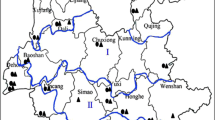Summary
On-farm conservation of landraces is one strategy to maintain the diversity of crop germplasm in local agro-ecosystems. The genetic structures of landraces are a key biological factor in on-farm conservation strategies. To accumulate a genetic understanding that will help establish a methodology for on-farm conservation, the genetic organization of landraces of aromatic rice in Namdinh province, Vietnam was analyzed using RAPD markers. Eighteen RAPD markers detected 38 genotypes among 320 aromatic rice samples growing at 23 sites of farmers' fields and in the experimental field that derived from 13 sites. Geographical variation was observed in the frequency of genotypes, whereas individual landraces could not be distinguished by RAPD markers. Genetic variation within a site was generally smaller than that among sites. The degree of genetic similarity of the plants in a site varied among sites, as did the number of genotypes. Changes in genetic structure over time were investigated using experimental populations each derived from approximately 30 plants from 13 farmers' fields. The differences detected by DNA markers between the genetic structural in the farmers' fields and those in experimental fields suggested that genetic drift is a major cause of these differences. The present study suggests that DNA markers are an essential means to monitor the genetic structures of heterogeneous landraces of rice, and are useful for selecting study sites for the on-farm conservation of genetic diversity as well as for successive monitoring.
Similar content being viewed by others
References
Alieri, M.A. & L.C. Merrick, 1987. In situ conservation of crop genetic resources through maintainance of traditional farming systems. Econ Bot 41: 86–96.
Astley, D., 1992. Preservation of genetic diversity and accession integrity. Field Crop Res 29: 205–224.
Ferguson, M.E., H.J. Newbury, N. Maxted, B.V. Ford-Lloyd & L.D. Robertson, 1998. Population genetic structure in Lens taxa revealed by isozyme and RAPD analysis. Genet Resourc Crop Evol 45: 549–559.
Frankel, O.H. & M.E. Soule, 1981. Conservation and evolution. pp.327. Cambridge Univ Press, New York.
Frankel, O.H., A.H.D. Brown, & J.J. Burdon, 1995. The conservation of biodiversity. pp.299. Cambridge Univ Press, New York.
Fu, Y.-B, A. Diederichsen, K.W. Richards & G. Peterson, 2002. Genetic diversity within arange of cultivars and landraces of flax Linum usitatissimum L.) as revealed by RAPDs. Genet Resourc Crop Evol 49: 167–174.
Ge, S., G.C.X. Oliveira, B.A. Schaal, L.Z. Gao & D.Y. Hongm, 1999. RAPD variation within and between natural populations of the wild rice Oryza rufipogon from China and Brazil. Heredity 82: 638–644.
Gichuki, S.T., M. Berenyi, D. Zhang, M. Hermann, J Schmidt, Josef Glossl & K. Burg, 2003. Genetic diversity in sweetpotato [Ipomea batatus (L) Lam.] in relationship to geographic sources as assesed with RAPD markers. Genet Resourc Crop Evol 50: 429–437.
Hamelin, R.C., J. Beaulieu & A. Plourde, 1995. Genetic diversity in populations of Cronartium ribicola in plantations and natural stands of Pinus strobus. Theor Appl Genet 91: 1214–1221.
Ingram, C.B. & J.T. Williams, 1984. In situ conservation of wild relatives of crops. In: J.H.W. Holden and J.T. Williams (Eds), Crop genetic resources: Conservation and evaluation, pp.162–179. George Allen and Unwin, London.
Li, Y.C., M.S. Roder, T. Fahima, V.M. Kirzhner, A. Beiles, A.B. Korol & E. Nevo, 2002. Climatic effects on microsatellite diversity in wild emmer wheat (Triticum dicoccoides) at the Yehudiyya microsite, Israel. Heredity 89: 127–32.
Maxted, N., B.V. Ford-Lioyd & J.G.Hawks, 1997. Complementary conservation strategies. In: N. Maxted, B.V. Ford-Lioyd & J.G. Hawks (Eds), Plant Genetic Conservation: The In Situ Approach, pp. 339–367. Chapman & Hall, London.
Maxted, N., L. Guarino, L. Myer & E.A. Chiwona 2002. Towards a methodology for on farm conservation of plant genetic resources. Genet Resourc Crop Evol 49: 31–46.
Murray, M.G. & Thompson, W.K. 1980. Rapid isolation of high molecular weight plant DNA. Nucleic Acids Res. 8: 4321–4325.
Olufowote, J.O., Y. Xu, X. Chen, W. D. Park, H.M. Beachell, M. Goto & S.R. McCouch, 1997. Comparative evaluation of within-cultivar variation of rice (Oryza sativa L.) using microsatellite and RFLP markers. Genome 40: 370–378.
Persons, B.J., H.J. Newbury, M.T. Jackson & Ford-Lloyd B.V. 1999. The genetic structure and conservation of aus, aman and boro rices from Bangladesh. Gen. Res. Cop Evol. 46: 587–598.
Rao, S.P., C. Bounphanousay, J.M. Sciller, A.P. Alcantatra & M.T. Jackson, 2002. Naming of traditional rice varieties bay farmers in the Lao PDR. Gen Res Cop Evol 49: 83–88.
Skroch, P.W., J. Nienhuis, S. Beebe & J. Tohme, 1998. Comparison of Mexican common bean (Phaseolus vulgaris L.) core and reserve germplasm collections. Crop Sci 38: 488–496.
Suh, H.S., Y.I. Sato & H. Morishima, 1997. Genetic characterization of weedy rice (Oryza sativa L.) based on morpho-physiology, isozymes and RAPD markers. Theor Appl Genet 94: 316–321.
Tin, H.Q., T. Berg & A. Bojornstad, 2001. Diversity and adaptation in rice varieties under static (ex situ) and dynamic (in situ) management. Eupytica 122: 491–502.
Turpeinen, T., T. Tenhola, O. Manninen, E. Nevo & E. Nissila, 2001. Microsatellite diversity associated with ecological factors in Hordeum spontaneum populations in Israel. Mol Ecol 10:1577–91.
Villand, J., P.W. Skroch, T. Lai, P. Hanson, C.G. Kuo & J. Nienhuis 1998. Genetic variation among tomato accessions from primary and secondary centers of diversity. Crop Sci 38: 1339–1347.
Williams, J.G.K., A.R. Kubelik, K.J. LivaK, J.A. Rafalski & S.V. Tingey 1990. DNA polymorphism amplified by arbitrary primers are useful as genetic markers. Nucl Asids Res 18: 6531–6535.
Wolfe, M.S. (1985) The current status and prospects of multiline cultivars and variety mixtures for disease resistance. Ann Rev Phytopathol 23: 251–273.
Yu, L.X. & H.T. Nguyen 1994. Genetic variation detected with RAPD markers among upland and lowland rice cultivars (Oryza sativa L.). Theor Appl Genet 87: 668–672.
Author information
Authors and Affiliations
Corresponding author
Rights and permissions
About this article
Cite this article
Fukuoka, S., Tran, S.D., Ebana, K. et al. Genetic organization of aromatic rice as revealed by RAPD markers: A case study in conserving crop genetic resources on farm. Euphytica 149, 61–71 (2006). https://doi.org/10.1007/s10681-005-9054-7
Received:
Accepted:
Published:
Issue Date:
DOI: https://doi.org/10.1007/s10681-005-9054-7




